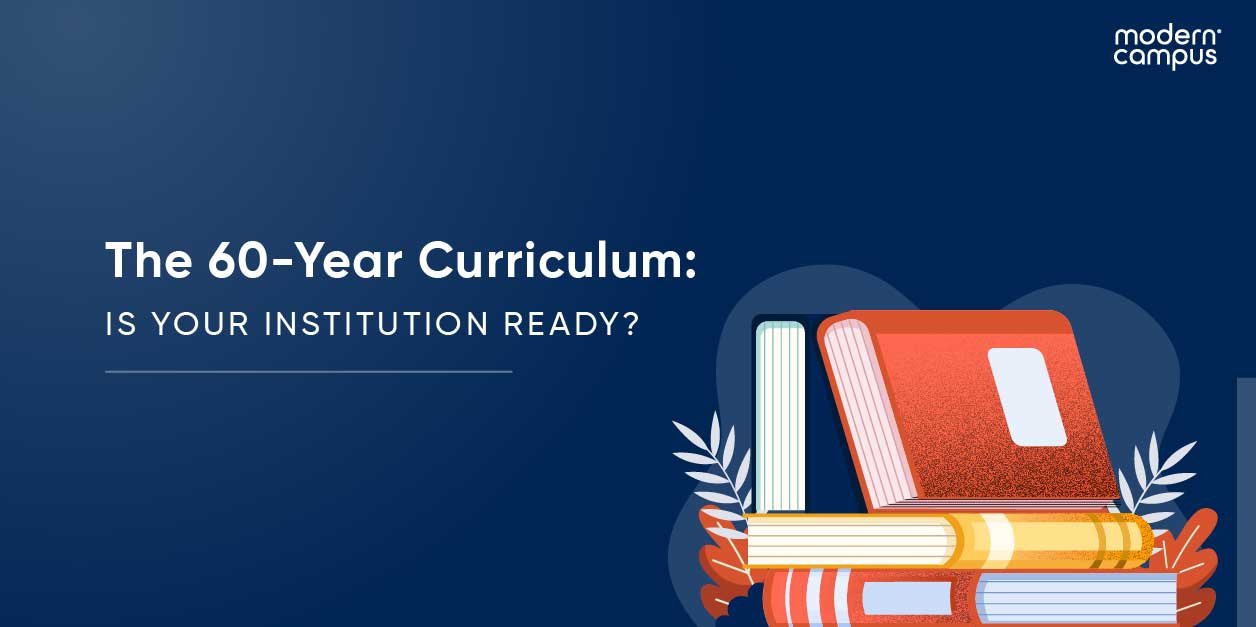The 60-Year Curriculum: Is Your College or University Ready?
It's a no-brainer that lifelong learning contributes to vitality, but now, as higher education is struggling to find ways to boost enrollment and keep the doors open, developing education that extends well beyond four or even eight years is becoming a more attractive and viable education model.
And the bottom line isn't the only reason for the change. As students transition from college to career, they no longer stay at the same company or even in the same field in the way their parents did. Many will return to school to supplement their skills and knowledge. Others will need to transition to new professions as automation increasingly replaces repetitive and routine tasks, leading to significant shifts in employment dynamics.
Higher ed is in the unique position to offer the courses and programming needed to stay relevant. This idea is called the 60-year curriculum model because it serves lifelong learners from college to retirement.
How Higher Education Can Thrive in the Digital Economy
The 60-year curriculum model is a necessary evolution for higher education institutions navigating rapid change. As the digital economy redefines how people learn, work and transition between multiple careers, colleges and universities must rethink their role in supporting lifelong learning and continuous upskilling.
Higher education now has the opportunity to serve learners across multiple stages of life, not just those in mid-adolescence. With the right tools and mindset, colleges and universities can become central players in both the education and workforce sectors. By aligning their offerings with emerging demographic shifts and the needs of a synergistic digital economy, institutions can start thinking strategically about how to build learning relationships that last a lifetime.

This approach doesn’t mean abandoning academic rigor; it means reimagining current programs with relevant content and inclusive design to meet students where they are. Whether it’s offering flexible credentialing pathways, incorporating learning technologies like AI and data mining or developing student life-wide opportunities, the 60-year curriculum offers a roadmap to increase learners’ trajectories while staying relevant in a world defined by constant transformation.
Embracing New Models to Serve the Modern Learner
The shift toward a 60-year curriculum calls for new models that go beyond traditional degree pathways. To support learners through continuous upskilling and evolving career needs, institutions must adapt how they deliver, credential and support education across a lifetime.
If your college or university is exploring the 60-year curriculum model, here are 3 things to consider:
1. Implement a Student-Centered Approach
Your school says they have a student-centered approach, but have they really looked at ways to streamline registration and administration that make it easy for the student to sign up and engage?
Implementing processes for lifelong learners has nothing to do with “dumbing down” academic programs but everything to do with making sure your traditional processes can accommodate and welcome this new type of student. Your lifecycle management software is one tool that can help you streamline and simplify rote tasks like registration.
Steps to Implement a Truly Student-Centered Approach
- Simplify the Enrollment Journey
Students, especially non-traditional learners, expect seamless, intuitive experiences. Start by removing barriers in your enrollment process through personalized web content, automated messaging and real-time updates that help guide students from discovery to registration without unnecessary friction. - Automate Routine Administrative Tasks
Free your staff to focus on strategic initiatives by automating repetitive processes like registration approvals, payment collection and course scheduling. Doing so supports operational efficiency and improves the student experience across multiple stages of their learning journey. - Offer Flexible Scheduling and Pathways
Learners balancing work, family and education need adaptable schedules. Provide course schedule personalization tools that let students align classes with their real-life commitments. You're offering vital support in education and workforce sectors that value continuous upskilling. - Use Data to Personalize Support
Tap into data mining tools to understand student behaviors, preferences and engagement patterns. Deliver tailored resources, nudges and communications that anticipate learner needs, driving both retention and meaningful opportunities. - Make Online Access Frictionless
Ensure your website and portals are mobile-friendly, accessible and easy to navigate. In the digital economy, your institution’s online presence should mirror the personalization and ease of use expected from modern tech platforms.
2. Complement Degrees With Credentials
The 60-year curriculum emphasizes developing educational models that enable individuals to reskill as their personal and professional development needs evolve. Colleges and universities are no longer solely focused on preparing students for a single academic program but are also tasked with ensuring that learners possess the adaptability to reinvent themselves throughout their careers.
Lifelong learners often lack the time, patience or financial resources to pursue a full degree each time their circumstances change. Consider how profound economic disruptions can impact students' lives. For instance, the Yale Budget Lab estimates that new tariffs enacted in 2025 will increase annual expenses for the average U.S. household by $3,800. In this context, credentialing offers a flexible alternative, complementing traditional degree paths by providing targeted, stackable qualifications that align with the dynamic demands of the digital economy.

As Mark Bramwell, Chief Information Officer of Oxford’s Saïd Business School, observes:
"If we want to extend, expand and grow our markets, the only way we can do that seriously is by looking into the online space, market and programs."
By integrating credentialing options into their offerings, higher education institutions can better serve the needs of modern learners, ensuring they remain competitive and capable in a rapidly evolving job market.
3. Transform Your Career Center into a Hub for Lifelong Learning
Your school's career center is both a recruitment tool and a bridge to building relationships with lifelong learners. Prospective students are interested in stats on job placement, while lifelong learners want career coaching, skills-specific workshops and networking events.
If you have a robust content management system (CMS), you'll be able to provide online classes, signups and alerts along with other information to make it easy for lifelong learners to access and engage with your campus. Approach your website and in-person offerings the same way major retailers do, with the customer at the center of all decisions.
Practical Ways to Evolve Your Career Center for Lifelong Learning
- Offer Career Reflect Tools
Help students of all ages evaluate where they are and where they want to go with tools that prompt critical thinking around career goals, personal strengths and market trends. This empowers learners to take ownership of their path while aligning it with the realities of the global economy. - Integrate Real-Time Labor Market Insights
Use platforms that provide up-to-date information on job demand, salary projections and skill requirements. These insights allow students to make informed decisions about continuing education and workforce development opportunities that support worthwhile employability. - Create Personalized Learning Pathways
Move beyond generic advising sessions by connecting learners to relevant content and programs based on their interests, goals and existing experience. Support flexible options like microcredentials, online learning and non-credit programs to appeal to learners in multiple stages of life. - Foster Community and Networking Opportunities
Facilitate ad hoc work connections, alumni mentorship programs and peer learning groups. These networks support students’ immediate needs and help them build relationships that continue well after graduation. - Embrace Inclusive, Accessible Design
Whether it’s through digital platforms or on-campus events, ensure your offerings are inclusive and accessible to diverse populations. Use your content management system to centralize career support resources, host virtual workshops and deliver a consistent experience across touchpoints.
If you don't make changes now, students will simply look elsewhere for the education, credentialing and resources they need to be successful.
The Future Belongs to Institutions That Act Now
Higher ed is in transition, and your college or university has an opportunity to capitalize on the changes ahead by strategizing about how to best meet non-traditional students' needs sooner rather than later. Is your school ready to take on this challenge? Non-traditional students aren't going to wait around to find out.
At Modern Campus, we empower institutions to meet these disruptive shifts head-on with tools built specifically for the evolving learner-to-earner lifecycle. From managing continuing education programs to personalizing online experiences and streamlining operations, we help higher education institutions attract, engage and retain learners for life. Let’s build the next era of lifelong learning together.
Up your game by downloading our white paper, 7 Ways to Attract and Retain New Audiences: Restructuring Higher Ed to Serve Learners for a Lifetime.
Last updated: June 10, 2025




